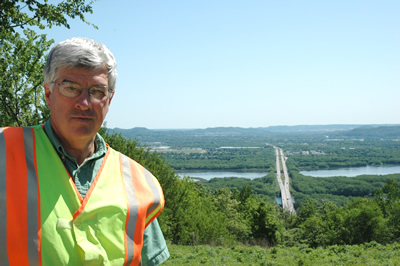By Craig Wilkins

Greg Husmann pauses for a moment on a bluff overlooking the Mississippi River Valley near Dresbach. Interstate 90 is in the background. Photo by Craig Wilkins |
Each workday, Greg Husmann gets up at 5 a.m., goes for a brisk walk with his wife, Faith Husmann, then hits the door at the Dresbach truck station by 6 a.m. with his high-energy presence.
His Mn/DOT career began in 1971 in Dresbach after completing military service during the Vietnam War.
In 1978, Husmann was appointed supervisor at the La Crescent sub-area, which includes truck stations at Caledonia, Houston and La Crescent. Before his permanent appointment, he served as a maintenance worker and temporary supervisor.
The region poses some unique challenges for Husmann and his staff, including highways that crisscross the hilly bluff country of southeastern Minnesota and roads frequently plagued by floods from the region’s fast-running rivers. His crews also maintain a section of Interstate 90.
Winters in the La Crescent sub-area tend to be a bit milder than other regions of the state, but ice storms are generally more frequent and severe.
Husmann’s career spans 35 years, a period in which he has experienced many changes.
What’s different between your rookie year with Mn/DOT and now?
Everything. For example during my first years, we had two guys in a snowplow truck. I was often the second guy, which meant I was the person who got out to shovel sand and salt from the bed of the plow truck.
We have fewer people now, but we have much better equipment and methods for snow removal and other kinds of work.
What has remained constant?
Our commitment to provide quality service to the public. Also, each employee’s willingness to adapt to or initiate better ways to do things. And there’s our sense of responsibility and pride in what we do.
It’s also still important for us to inform the public about what we’re doing, when we’re going to do it and why. In other words, being accountable for what we do. Sometimes we can get a little paranoid about working with the news media, but we need to remember that we need reporters to get our message across about traffic, safety and other issues.
We continue our emphasis on safety with regular training and talks about specific incidents or situations.

Scott Dole, La Crescent truck station, and Dick Pederson, Caledonia truck station, both transportation generalists, meet with Husmann at La Crescent before moving on to their next assignment. Photo by Craig Wilkins
|
What is your management style?
Managing this sub-area is pretty easy because all of our people are smart, think and want to be there. I should know, I’ve hired most of them. Basically, it’s creating trust and respect.
When I ask employees to do a task, I value their knowledge and experience. Together, we decide how to do it or whether we can do it at all.
The crew at Caledonia became a self-directed work team long before we started using the term around here. Crew members there meet every day and decide what tasks are most needed to support our sub-area’s goals and mission.
When problems arise, I find the best way to deal with them is right away—and directly. That way, the problem doesn’t get in the way of other things and resolving it may even help us learn something.
What keeps you working year after year without losing your enthusiasm?
I’m proud of the work we do providing a valuable public service. We have a box full of letters from the public thanking us for what we do; that’s quite a motivator. And I get a lot of my energy from working with the sub-area crew, other district staff and from frequent contacts with the public.
The people in our sub-area get along well, respect others and do a great job. They are good people. All of that helps get me here and ready to go each morning. I’m grateful for that.
This is one in a series of articles featuring Mn/DOT employees on-the-job. Do you or a co-worker have an interesting job to share with readers? Click here to send us your ideas, and we’ll contact you for more information.
Recent on-the-job profiles:
|



